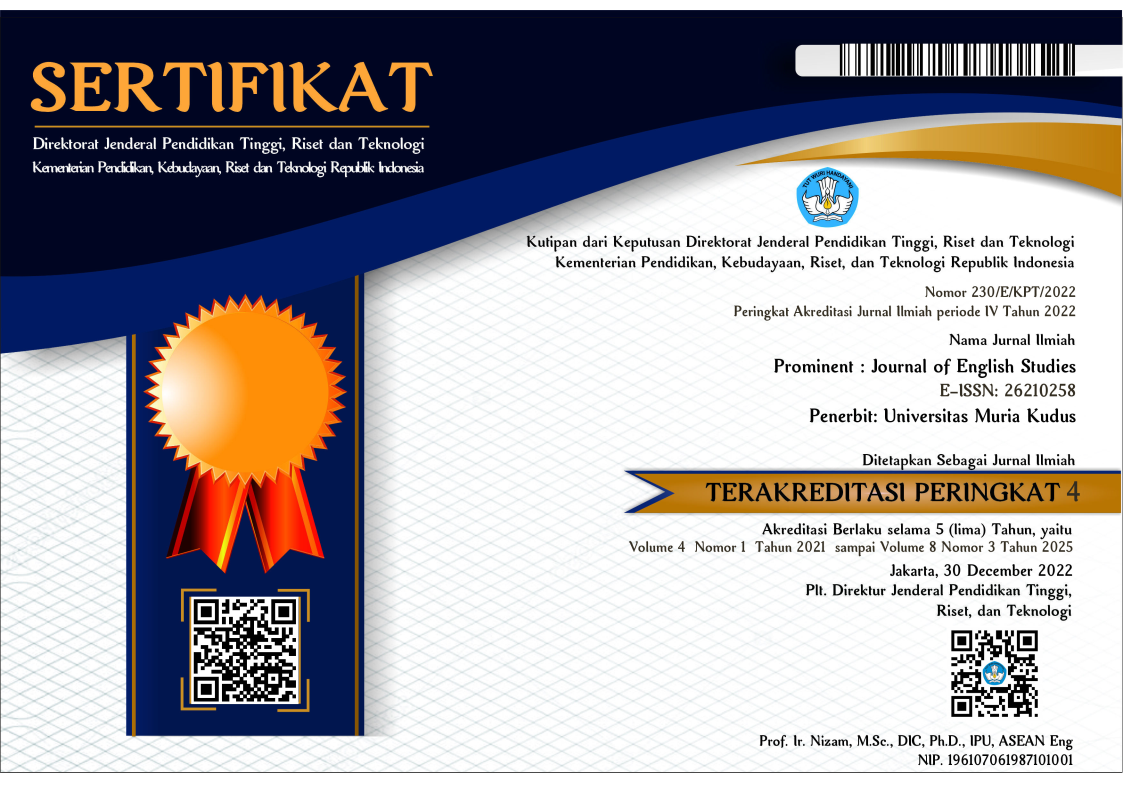STUDENTS’ PERCEPTION ON THE APPLICATION OF TIMED WRITING PRACTICE (TWP)
Abstract
Abstract
This preliminary research is as a part of learning need analysis for developing a discourse based writing material with a timed-writing technique in an English teacher education department in Indonesia. In timed writing practice (TWP), students must write a paragraph on a sheet of paper without help in a given time limit. However, no empirical information on whether the students agree or disagree with the application of timed writing and the reasons behind their perceptions is not yet avaiable.The research subjects consist of 31 students who take writing course. The objectives are to investigate (1) the extent of the students’ acceptance and (2) the reasons behind the acceptance on the application of timed-writing practice (TWP) in writing class. A qualitative analysis is administered by identifying and classifying contents of students’ opinions and reflections expressed in the students’ responses to questionare. Twenty five students (81%) agree with the application of TW. Four students (13%) disagree and 2 students (6%) give no preference. Timed writing are perceived as (1) Encouraging Writing Activity, (2) Improving Time Management and Control, (3) Training Thinking Skills, (4) Improving Writing Skills, (5)Training Speed Writing, (6) Improving Soft Skills, (7) Giving Challenging Activity, and (8) Improving Concentration and Accuracy. The reasons from those who disagree are: (1) Feeling nervous and confused (2) Having insufficient preparation time, and (3) Expecting Variation of Activity. In conclusion, timed writing is mostly accepted and positively perceived by the students with very high category. Reasons from those who disagree must also be taken into consideration for future betterment. Based on the research findings, the timed writing, accordingly, can be used as a technique or a strategy to be integrated in a discourse-based writing material for students of English teacher education program.
Key Words: Timed-Writing, Students’ Acceptance, Reasons
Full Text:
PDFReferences
Aidinlou, Nader Assadi. (2004). A Discourse-based Teaching of Writing for Iranian EFL Students: A SystemicPerspective. Journal of English Language Teaching and Learning No 8. http://home.utah.edu/~u0404503/PDF/School/Power%20Points/why_writing_is_so_important.pdf
Ayotte, Stacey-Beth Mackowiak. (2018). Timed-writing in the Foreign Language Classroom: Does practice make perfect?
http://crisolenguas.uprrp.edu/Articles/Timedwriting%20in%20the%20Foreign%20Lanfuage%20classroom.pdf
Bounds, Gwendolyn. (2010). In Digital Age, Does Handwriting Still Matter? in https://blogs.wsj.com/juggle/2010/10/04/in-digital-age-does-handwriting-still-matter/
Celce-Murcia, Mariana. (2018). Rethinking the Role of Communicative competence in Language Teaching. In https://www.google.com/search?q=Rethinking+the+Role+of+Communicative+Competence+in+Language+Teaching+&ie=utf-8&oe=utf-8&client=firefox-b (accessed on 16 September 2018)
Celce-Murcia M, Olshtain E (2000) Discourse and Context in Language Teaching. Cambridge University Press, Cambridge .
Claire Whittaker. (2005-8). Redesigning a blended learning course: Introducing new technologies for ELT in Managing Change in English language Teaching: Learning from Experiences; British Council edited by Christopher Tribble © British Council 2012 Brand and Design/B33010 Spring Gardens London SW1A 2BN, UK www.britishcouncil.org
ETS. (1996). Toefl Test of Written English Guide. Princeton: Educational Testing Service
Gall, Meredith and Gall, Joyce, Borg, Walter. (2003) .Educational research: An
Introduction (7th ed.). New York: Longman.
Hosseini, Monirosadat and Mohamad Ehsan Taghizadeh, Mohamad Jafre Zainol Abedin,, Elham Naseri. (2013). The the Importance of EFL Learners' writing Skill: Is there any Relation between Writing Skill and Content Score of English Essay Test? International Letters of Social and Humanistic Sciences Online: 2013-09-25 ISSN: 2300-2697, Vol. 6, pp 1-12. doi:10.18052/www.scipress.com/ILSHS.6.1 © 2013 SciPress Ltd., Switzerland
Lougheed, Lin. (2008). Barron’s IELTS International English Language Testing System. Tangerang: Binarupa Aksara Publishing, Co.
Lund, R Elisabeth. (2010). Handwriting as a tool for learning in ELT in ELT Journal, Volume 70, Issue 1, 1 January 2016, Pages 48–56. https://doi.org/10.1093/elt/ccv048
Megawangi, Ratna. (2004). Pendidikan Karakter Bangsa Sebagai Solusi Tepat untuk Membangun Bangsa. Jakarta: Indonesia Heritage Foundation.
O’Malley, J. Michael and Pierce, Lorraine Valdez. (1996). Authentic Assessment for English Language Learners. Practical Approaches for Teachers. US: Addison-Wesley Publishing Company, Inc. p. 143 (Holistic scoring rubric Developed by ESL teachers, Prince William County Public Schools, Virginia)
Oshima, A and Ann Hogue. (2006). Writing Academic English. New York: Pearson Education (pp.263-330).
Putra, Ichsan S and Aryanti Pratiwi. (2005). Sukses dengan Soft Skills. Bandung: Direktorat Pendidikan Institut Teknologi Bandung. P. 5
Rodgers, Derek. (2018). Using Timed Practice with Repeated Writings to Promote Sentence-Writing Fluency. Posted on: May 1, 2018 in https://iowareadingresearch.org/blog/teaching-writing-fluency-timed-practice-part-1
Syafei, Muh. (2012). Backwash Effects of Portfolio Assessment in Academic Writing Classes. TEFLIN Journal. Volume 23 Number 2 July 2012. p 22.
http://www.teflin.org/journal/index.php/journal/article/download/146/138
Syafei, Muh. (2014). Enhancing Students’ Soft Skills through PWP (Pressure Writing Practice): A Reflection in a Writing Class. A paper presented at UNNES ELTLT International Conference.
http://eprints.umk.ac.id/4461/2/daftar_isi_prosiding_ELTLT_3.pdf
https://www.howjournalcolombia.org/index.php/how/article/view/57 Blended Learning in the Teaching of English as a Foreign Language: An Educational Challenge
http://www.knowledgewave.com/blog/benefits-of-blended-learning. US Dept of Education, 2010.
DOI: https://doi.org/10.24176/pro.v2i1.3044
Article Metrics
Refbacks
- There are currently no refbacks.





